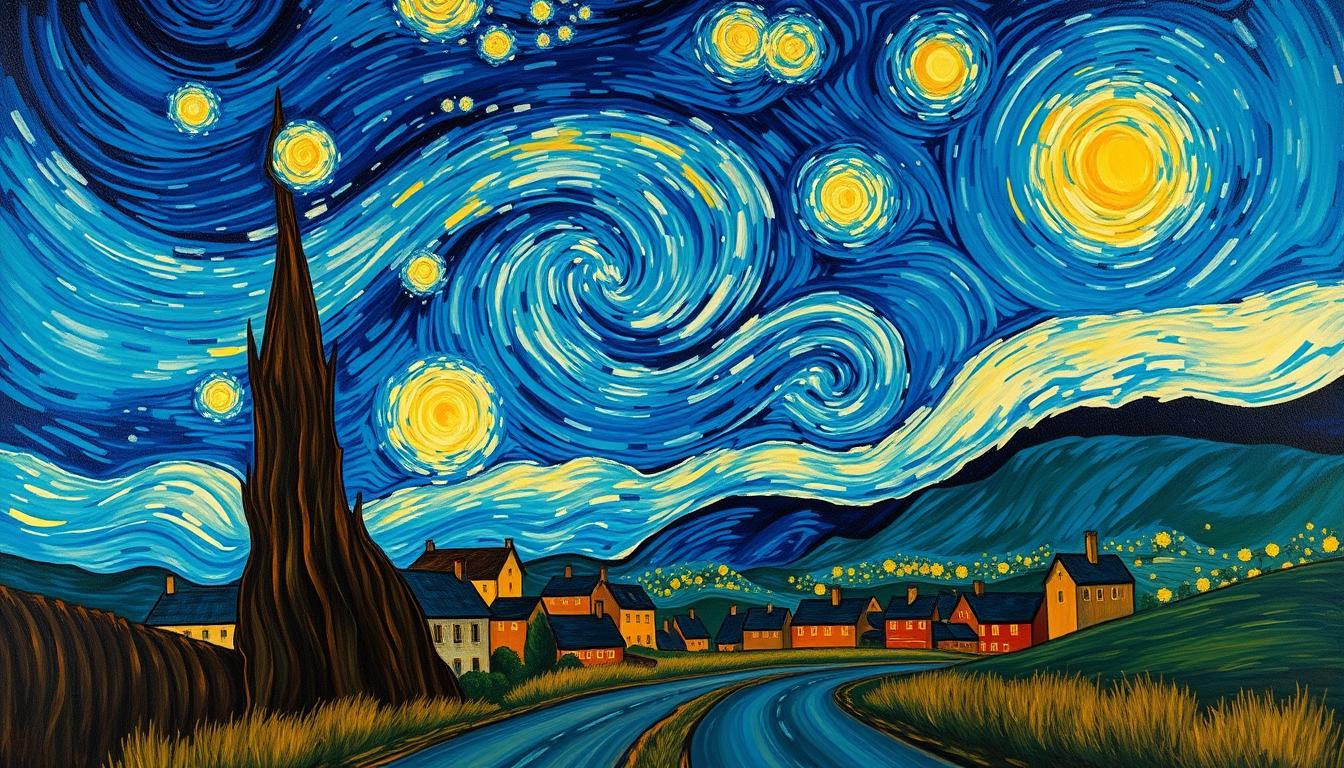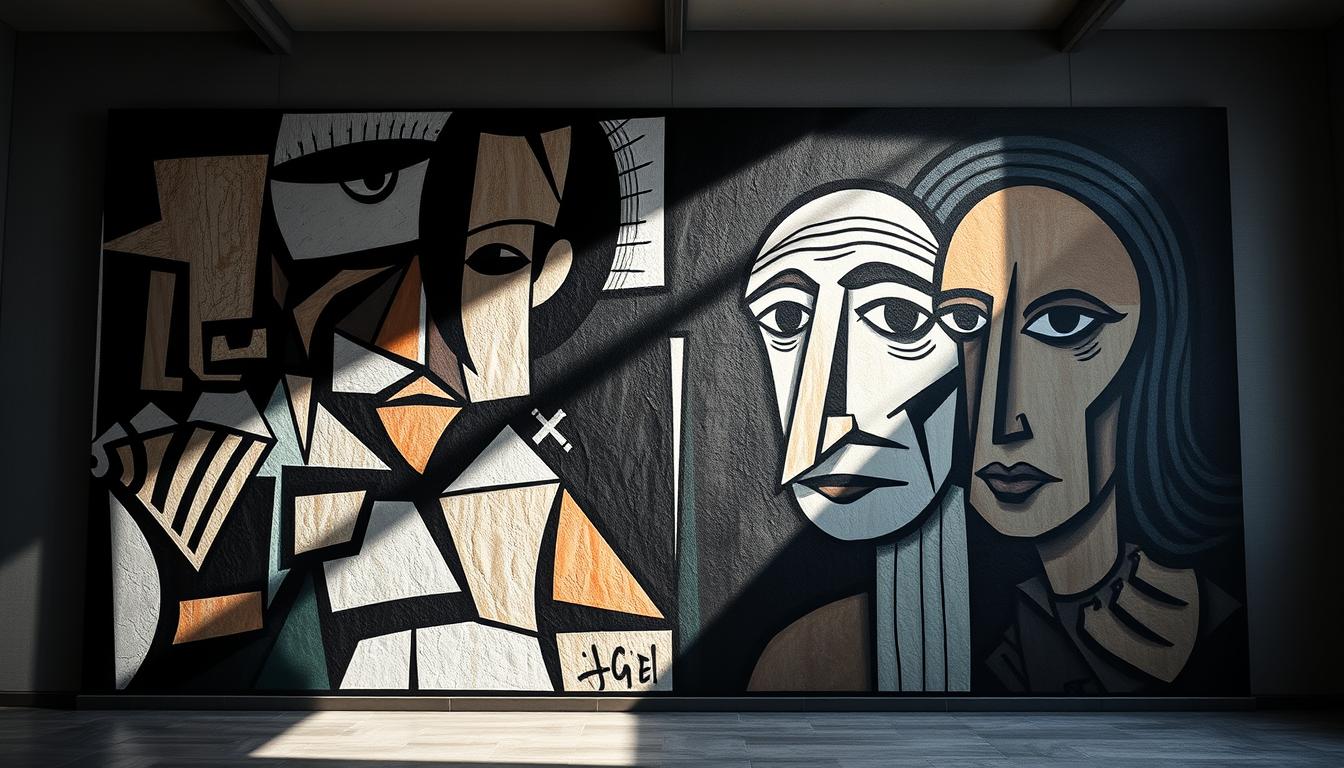
Can a work that shows a village, a cypress, and a moon still be called pure abstraction?
Vincent van gogh painted this famous canvas in 1889 while at Saint-Paul-de-Mausole in Saint-Rémy-de-Provence. The oil on canvas measures 73.7 x 92.1 cm and lives at MoMA in New York.
The work sits with Post-Impressionism. Its bold color, swirling sky, and expressive brushwork make it feel intense and modern. Yet the village, church steeple, and cypress remain recognizable forms in the scene.
Van Gogh mentioned a “night effect,” Venus, and even called the piece a “failure” in letters to Theo and Émile Bernard. Those notes reveal the artist’s struggle and the painting’s aim to blend feeling with the visible world.
Later sections will unpack composition, style, and meaning so you can decide where the painting falls on the spectrum between expression and full abstraction.
Key Takeaways
- The question frames a careful look at style rather than a quick label.
- The painting dates to 1889 and was made by van gogh at Saint-Rémy.
- Bold swirls and color convey emotion while keeping readable forms.
- Letters from the artist reveal doubt and intent behind the work.
- It sits in Post-Impressionism—expressive, not purely abstract.
- Its fame and value stem from both emotional power and observable forms.
Short answer: where The Starry Night sits between realism and abstraction
Here, pictorial elements remain identifiable even as paint pushes feeling forward. In clear terms, the painting keeps a village, cypress, moon, and hills you can read. Yet the surface bristles with motion and intensified color.
What “abstract” means in art history versus everyday use
In art history, true abstraction moves away from representing the visible world toward pure shapes, line, and hue, as seen later with Kandinsky and Mondrian. Vincent van gogh died before those movements took hold, so his work predates the full turn to nonrepresentational art.
In everyday speech, people call anything stylized or non-photorealistic “abstract.” That explains why viewers sometimes label this painting the same way even when its subject stays legible.
Why van Gogh’s night sky remains recognizably real
The composition keeps a horizon and a sensible distribution of stars and moon, so your eye identifies land and sky. Van Gogh used brushwork and color to heighten emotion, not to erase forms.
Takeaway: In strict art-historical terms, this work is a highly expressive representation rather than pure abstraction. Its balance of feeling and form shows van gogh’s singular way of seeing the world.
Vincent van Gogh in 1889: life, letters, and the Saint-Rémy window
Saint-Rémy became van gogh’s home in 1889; the view from his window and the asylum’s routine shaped many canvases. He lived in two rooms: a bedroom with an east-facing window toward the Alpilles and a separate studio. That vantage gave him a real horizon to anchor imagined skies.
Asylum setting, view toward the Alpilles, and painting from memory
Daily life at Saint-Paul-de-Mausole limited travel but offered long stretches to work. Van gogh often painted from memory or imagination when he could not paint outdoors. This mix explains why the village and hills feel observed yet slightly invented.
Letters to Theo and Émile Bernard: “night effect,” Venus, and “failure”
The artist’s letters reveal process and mood. In correspondence with Theo and Émile Bernard he mentions a “night effect” and notes Venus as the morning star. He even called the finished work a “failure” in a candid moment.
"I have tried to express the night, the moon, and the morning star as I felt them."
Those letters—part of roughly 600 pieces to Theo—give first‑hand insight into his life, his time in the asylum, and why observation and memory blended in his painting.
Read more about this period in a detailed account at van gogh’s Saint-Rémy stay.
The Starry Night at a glance: facts, movement, and where to see it
The Starry Night remains a concise reference for students, visitors, and lovers of late-19th-century painting.
Post-Impressionism, oil on canvas, and MoMA, New York
This painting dates to 1889 and was made by Vincent van Gogh during his stay at Saint-Paul-de-Mausole in Saint-Rémy-de-Provence.
It is oil on canvas, measures 73.7 x 92.1 cm, and belongs to the Post-Impressionism movement. The canvas is housed at The Museum of Modern Art (MoMA) in New York.
- Genre: Landscape at night
- Estimated worth: over $100 million
- Significance: key work in art history and a touchstone for modern artists
| Title | Artist | Date | Medium / Size |
|---|---|---|---|
| The Starry Night | Vincent van Gogh | 1889 | Oil on canvas, 73.7 x 92.1 cm |
| Movement | Genre | Location | Value |
| Post-Impressionism | Landscape | MoMA, New York | Estimated > $100 million |
Quick note: This canvas stands among van Gogh’s nocturnes and helped shift focus from optical impressionism toward expressive structure.
How brushstrokes and color build an “emotional reality”
You notice motion first: circular brushwork animates the sky and pulls the scene together.

Swirls, impasto, and flowing lines
Thick impasto and looping brushstrokes make the sky tactile. The paint sits on the surface like relief and catches gallery light.
The arcs and spirals act as lines of force. They guide your gaze from the dark cypress up into glowing stars.
Blue and yellow: contrast as light and feeling
Van Gogh pairs deep blue with vivid yellow to create visual vibration. Those complementary colors make halos around stars seem to pulse.
The result is symbolic light—not just a bright spot, but a feeling of radiance that moves across the scene.
Continuity across subjects and mood
Similar handling appears in Café Terrace at Night and Wheatfield with Crows. The same sculptural brushwork and bold colors link these canvases.
Takeaway: This combination of brushstrokes, color, and composition produces an emotional reality where sensation leads, yet the subject stays clear.
"I wanted to express what the night feels like, not only what it looks like."
- Thick strokes create motion you can see and almost feel.
- Blue vs. yellow produces optical intensity and symbolic glow.
- Rhythmic lines shape the composition and move the eye.
Is Starry Night abstract? Parsing style, subject, and recognition
The canvas keeps clear landmarks you can name: a cypress in the foreground, a clustered village with a church steeple, hilly terrain, a crescent moon, and a bright Venus. These readable forms make the scene a night landscape rather than a purely nonrepresentational exercise.
Recognizable elements that anchor the view
The tall cypress and the steeple give the eye anchors. Stars, moon, and the morning star remain identifiable, so your brain maps sky and land quickly.
Post-Impressionism versus later turns to nonrepresentational form
Van Gogh and other Post-Impressionist artists used bold color and structure to heighten feeling while keeping subjects legible. Monet’s interest in light and Gauguin’s simplifications share that aim.
Later artists such as Kandinsky moved toward full nonrepresentational work, which clarifies the difference in art history.
In short, the painting touches on the abstract in surface and motion, yet the subject stays clear. That balance is why the work still makes strong visual and emotional sense for many viewers.
Meaning in the motif: cypress trees, composition, and symbolism
A tall cypress cuts the composition, acting as a visual hinge between earth and sky.
The tree carries layered meaning. Historically, cypresses link to death, funerary sites, and the afterlife. At the same time, van Gogh studied these trees like he studied sunflowers — as formal challenges that test brushwork and line.
The composition emphasizes a wide sky above a compact landscape. That choice makes the small village feel fragile beneath cosmic motion. The cypress and the church steeple echo each other vertically, tying lower and upper zones into a single visual idea.
Death, heaven-and-earth, and the artist’s life
Scholars read the cypress as a bridge between heaven and world. Others see it as a personal symbol of turmoil or spiritual longing.
"I wanted to express what the night feels like, not only what it looks like."
Van Gogh’s letters remind us he pursued cypresses both for study and for feeling. That mix lets the scene support many interpretations without forcing one fixed story.
- The trees act as symbolic and formal motifs.
- Scale choices shift the painting toward cosmic perspective.
- Placement ties foreground and village into a unified statement.

| Motif | Possible meanings | Formal role |
|---|---|---|
| Cypress | Death, bridge to heaven, study subject | Vertical anchor, links sky and land |
| Church steeple | Community, faith, human scale | Repeats vertical line, balances cypress |
| Sky vs. village | Cosmic scale, human smallness | Shifts focus to emotional vastness |
Science meets art: turbulence, Venus, and the night sky
Scientists and art lovers have long compared the painted motion to real atmospheric flow. The canvas blends observation and invention to create a convincing night sky.
Kolmogorov-like swirls and atmospheric eddies in paint
Researchers note that the large whorls break into smaller curls much like turbulence. In plain terms, big eddies hand energy down to smaller ones, and the paint mimics that cascade.
The result: the sky feels alive. The painter’s lines act like moving air and make the surface read as natural motion.
Morning star, the moon’s phase, and observed light
Astronomical checks show Venus would have been visible before dawn at Saint-Rémy, matching the artist’s morning-star note. That point anchors the painting in a real sky seen from a window.
By contrast, the crescent moon here likely reflects choice over strict accuracy. The moon’s form and the halos around stars are both observation and poetic invention.
| Element | Scientific read | Artful effect |
|---|---|---|
| Swirls | Kolmogorov-like cascade of eddies | Dynamic motion, visual energy |
| Venus | Visible pre‑dawn at Saint‑Rémy | Anchors scene to real time |
| Moon | Phase likely different historically | Expressive symbol of night light |
| Halos & glow | Scattering/atmospheric luminosity | Heightened radiance, mood |
This small science lesson does not strip away poetry. A writer, a scientist, or an art lover may read the work differently, yet all can share awe for how nature and craft meet in the painted sky.
Conclusion
This closing note ties the painting’s vivid motion to van gogh’s lived time and letters. The canvas blends an observed sky—with Venus at dawn—and deliberate departures like a crescent moon and amplified swirls.
The work remains a readable painting: a compact village, roofs in the foreground, and a tall cypress hold the scene together. At the same time, brushstrokes and colors push feeling forward, guiding the eye across a living sky.
In short, strong, the piece sits at the crossroads of representation and expression. It influenced later artists, links to Café Terrace at Night, and keeps the subject intact while opening new ways to see the night.
Enhance Your Space with Unique Modern Masterpieces
Are you inspired by the innovative mediums and conceptual depth highlighted in our exploration of contemporary art? You’re not alone! Today’s art enthusiasts are seeking cultural relevance and emotional connections in their artwork. However, finding pieces that resonate with modern themes and fit your unique style can be a challenge. That’s where we come in!
At Rossetti Art, we specialize in canvas prints, original paintings, and modern sculptures that celebrate the spirit of now. Each piece created by Chiara Rossetti brings a personal touch that connects deeply with current social narratives—just like the modern masterpieces discussed in the article. Don’t miss out on the chance to elevate your home decor with breathtaking artwork that speaks to your values and aesthetic. Explore our collection today and find your perfect piece! Act now, and transform your space into a gallery of inspiration!
FAQ
Is The Starry Night considered abstract?
The painting blends recognizable elements with expressive shape and color. Vincent van Gogh painted cypress trees, a village, a crescent moon, and bright stars, so the scene stays identifiable. Yet he exaggerates form and motion so the work moves away from strict realism toward emotional interpretation.
Where does The Starry Night sit between realism and abstraction?
The piece occupies a middle ground. It keeps a readable landscape while applying distorted lines, thick paint, and dramatic color to convey feeling. That places it in Post-Impressionism, a stage where artists reshaped visual facts to express inner states.
How does “abstract” differ in art history versus everyday speech?
In everyday use, abstract often means hard to picture or vague. In art history, abstract means a deliberate move away from depicting the visible world. Van Gogh did not reject representation entirely; he altered reality to create mood rather than inventing nonrepresentational forms.
Why does van Gogh’s night sky remain recognizably real?
He kept essential cues—horizon, buildings, trees, and familiar celestial bodies. Those anchors let viewers read the scene as nighttime landscape even as swirling brushwork and color intensify the emotional content.
What was van Gogh’s life like in 1889 when he painted this work?
He stayed at the Saint-Rémy asylum in southern France, coping with mental distress but painting prolifically. The view from his window and memories of other scenes informed many canvases produced during that year.
Did van Gogh paint The Starry Night directly from the asylum window?
He combined what he saw with memory and imagination. The asylum view faced a different direction, so the finished composition mixes observation, recollection of Alpilles hills, and inventive brushwork.
What do van Gogh’s letters reveal about his intentions?
Letters to his brother Theo and to Émile Bernard mention his search for “night effect,” interest in Venus, and his mixed feelings about success. They show he studied light carefully and aimed to express feeling through night scenes.
What are the basic facts about The Starry Night?
Painted in 1889, oil on canvas, it belongs to Post-Impressionism and is part of the Museum of Modern Art collection in New York. The work measures roughly 29 by 36 inches and remains one of van Gogh’s most famous canvases.
How do brushstrokes and color create an “emotional reality”?
Van Gogh used energetic swirls, thick impasto, and rhythmic lines to suggest movement and mood. Bold contrasts of blue and yellow amplify luminosity and emotional tension, turning a night scene into an expressive landscape.
What role do blue and yellow play in the painting?
Complementary contrast makes lights pop and deepens shadow. Blue fields set a cool backdrop while yellow highlights convey warmth and spiritual light, producing visual vibration that feels alive.
Are there links between this work and van Gogh’s other night scenes?
Yes. From café terrace evenings to paintings of wheatfields and moonlit landscapes, he repeatedly explored nocturnal light, atmosphere, and mood, refining a personal style that blends observation with emotion.
Which forms in the painting remain clearly recognizable?
Cypress trees, the clustered village, the rolling hills, bright stars, and a crescent moon are all discernible. Those forms anchor the viewer even as paint handling intensifies drama.
How does Post-Impressionism differ from pure abstraction in relation to this canvas?
Post-Impressionism keeps subject matter but alters color, line, and composition to convey inner feeling. Pure abstraction drops representational reference entirely. Van Gogh’s work modifies reality rather than abandoning it.
What symbolism do the cypress trees carry?
Cypress motifs often suggest connections between earth and sky and can evoke mortality or spiritual longing. In van Gogh’s hands they also provide vertical contrast to swirling skies and heighten emotional tension.
Does science explain the swirling patterns in The Starry Night?
Scholars have noted visual similarities between the painting’s vortices and fluid dynamics patterns studied in physics. Those parallels are intriguing but don’t mean van Gogh intentionally modeled scientific turbulence; they show how vivid observation can echo natural laws.
What about Venus and the crescent moon in the scene?
Van Gogh mentioned the morning star in letters, and astronomers have identified a bright planet visible at the time. The crescent moon’s portrayal serves both compositional and atmospheric purposes, anchoring the nocturnal setting.






Leave a comment
This site is protected by hCaptcha and the hCaptcha Privacy Policy and Terms of Service apply.